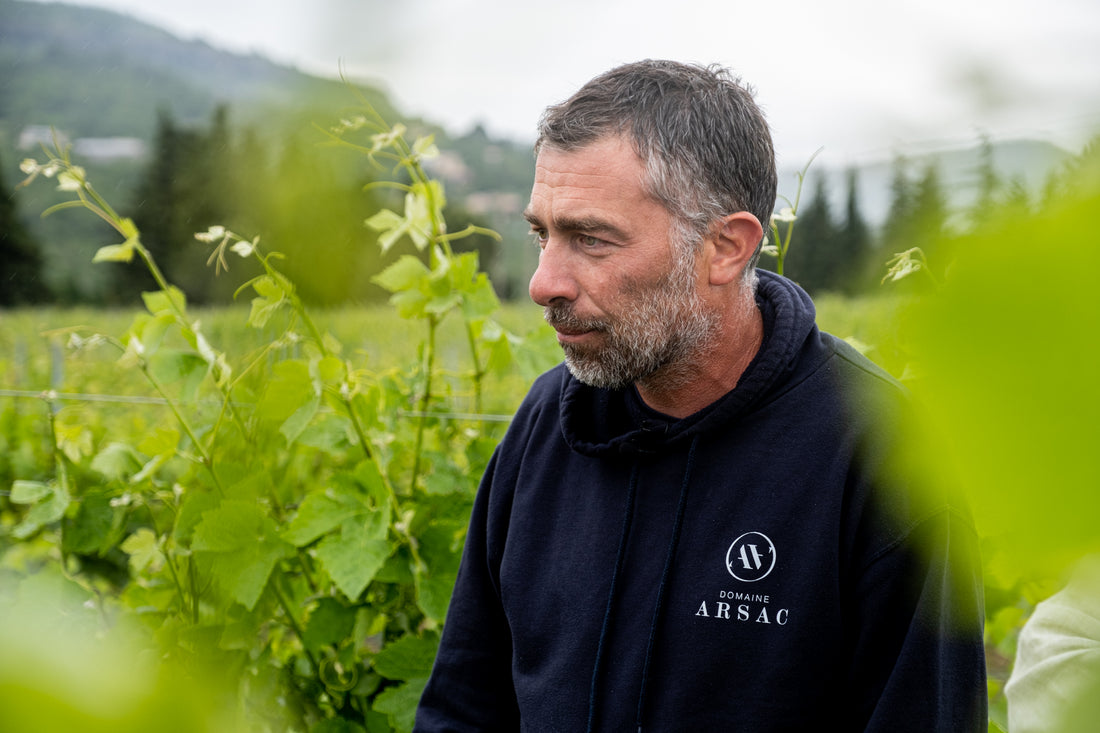Domaine Arsac is Growing Beautifully.
Have you ever walked by a particularly beautiful garden and been taken by an aroma? While we walked through the sunny vineyards of Sébastien Arsac, we noticed a persistent aroma of flowers in the air. When one of us asked what the pretty yellow blooms were, Séb said it was, “Jauné.” Yellow, in French.
What kind of flower is that? We thought. One thing was certain: it was a marvel to behold such a beautiful thing emerge from what was basically stone.
Like the mysterious Jauné flower, Domaine Arsac has bloomed itself, in a place no one thought it could.
Arsac was one of the first wineries in this part of the Ardèche, a network of forests, rivers, and mountains near the Rhône River. Sébastien’s grandfather, Gaston, had returned to the Ardèche in 1945 from Germany where he had been a prisoner of war, and wedded Therese in 1945 too.
They decided to make hay while the sun shone - although the region had long been thought to be too rugged and harsh to grow grapes for the production of wine, Gaston planted grapes anyway, all kinds. “He planted hybrids, unusual stuff, along with traditional grapes,” Séb tells us, “We still have some seventy-year-old Grenache.” 
The farm sits on the weathered black rock of a volcano called the Coiron, once active for some eleven million years, literally forming the country of France. The basaltic rock is still glassy and dark.
Séb tells us, there’s a saying in France, “the farmer cries everyday.” Whether it’s the weather, or the market, the life of the farmer is hard.
My own father grew up on a farm, “I never wanted to do it,” he told me many years ago, “Your life revolves around something you can’t control.” Ironically, he became an economist.
But the Arsacs were different, their faith in the place where they grew themselves powered them to grow something beautiful on their ancestor’s land. The secret of the organic grower is that their exacting methods actually make life easier in the long run than the conventional one.
An organic ecosystem self-regulates - without the introduction of outside chemicals, the local fauna and flora, the bees, the deer, and what we call “weeds,” protect the vineyard from temporary environmental conditions (most of the time).
Despite a dry season, Arsac’s cover crops have held water in this very porous soil which the vines drink from. Apart from the “jauné,” there are chestnut trees all over, and more indistinguishable flowers between the vines, and tall, tall grasses.
Sébastian isn’t satisfied with what’s there now, though. The earth is changing, and he’s introduced several experimental plantings to adapt to the climate. The great white grape of Sardinia and Southern France, Vermentino, has found an unlikely home here. The famous grape of Santorini, Assyrtiko, is blooming too. Grapes from hot places.
He also dreams of producing a varietal wine of an ancient grape called, Chatus. An original from the Ardèche, thought to make the finest wines of the area back in the 17th century. Now, it’s virtually extinct. It was never a part of the history of the Arsacs, but it seems fated that this orphaned grape vine would find a home in these black hills.

While we walk through the vineyards, Séb points out a rock formation, “the Basaltic Organ.” Tall columns of dark gray stone rise neatly like the pipes of a church organ, “Isn’t it so beautiful,” he remarks.
After our visit, and a little research, we found the flower that freckled the lines of vines is called, “Jauné Desplez,” and is noted for its pungent aroma, and its ability to thrive in unfavorable conditions. When you enjoy the colors of the labels on Domaine Arsac’s botttles, they are in the language of flowers, and the wines inside are somehow even more beautiful.

